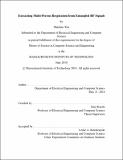| dc.contributor.advisor | Dina Katabi. | en_US |
| dc.contributor.author | Yue, Shichao | en_US |
| dc.contributor.other | Massachusetts Institute of Technology. Department of Electrical Engineering and Computer Science. | en_US |
| dc.date.accessioned | 2018-09-17T14:50:53Z | |
| dc.date.available | 2018-09-17T14:50:53Z | |
| dc.date.copyright | 2018 | en_US |
| dc.date.issued | 2018 | en_US |
| dc.identifier.uri | http://hdl.handle.net/1721.1/117817 | |
| dc.description | Thesis: S.M., Massachusetts Institute of Technology, Department of Electrical Engineering and Computer Science, 2018. | en_US |
| dc.description | This electronic version was submitted by the student author. The certified thesis is available in the Institute Archives and Special Collections. | en_US |
| dc.description | Cataloged from student-submitted PDF version of thesis. | en_US |
| dc.description | Includes bibliographical references (pages 53-56). | en_US |
| dc.description.abstract | Recent advances in wireless systems have demonstrated the possibility of tracking a person's respiration using the RF signals that bounce off her body. The resulting breathing signal can be used to infer the person's sleep quality and stages; it also allows for monitoring sleep apnea and other sleep disordered breathing; all without any body contact. Unfortunately however past work fails when people are close to each other, e.g., a couple sharing the same bed. In this case, the breathing signals of nearby individuals interfere with each other and super-impose in the received signal. This thesis presents DeepSleep, the first RF-based respiration monitoring system that can recover the breathing signals of multiple individuals even when they are separated by zero distance. To design DeepSleep, we model interference due to multiple reflected RF signals and demonstrate that the original breathing can be recovered via independent component analysis. We design a full system that eliminates interference and recovers the original breathing signals. We empirically evaluate DeepSleep using 21 nights of sleep and over 150 hours of data from 13 couples who share the bed. Our results show that DeepSleep is very accurate. Specifically, the differences between the breathing signals it recovers and the ground truth are on par with the difference between the same breathing signal measured at the person's chest and belly. Thesis Supervisor: Dina Katabi | en_US |
| dc.description.statementofresponsibility | by Shichao Yue. | en_US |
| dc.format.extent | 56 pages | en_US |
| dc.language.iso | eng | en_US |
| dc.publisher | Massachusetts Institute of Technology | en_US |
| dc.rights | MIT theses are protected by copyright. They may be viewed, downloaded, or printed from this source but further reproduction or distribution in any format is prohibited without written permission. | en_US |
| dc.rights.uri | http://dspace.mit.edu/handle/1721.1/7582 | en_US |
| dc.subject | Electrical Engineering and Computer Science. | en_US |
| dc.title | Extracting multi-person respiration from entangled RF signals | en_US |
| dc.type | Thesis | en_US |
| dc.description.degree | S.M. | en_US |
| dc.contributor.department | Massachusetts Institute of Technology. Department of Electrical Engineering and Computer Science | |
| dc.identifier.oclc | 1051460498 | en_US |
